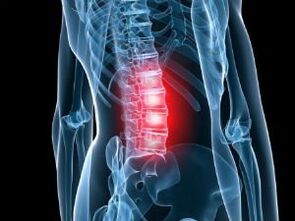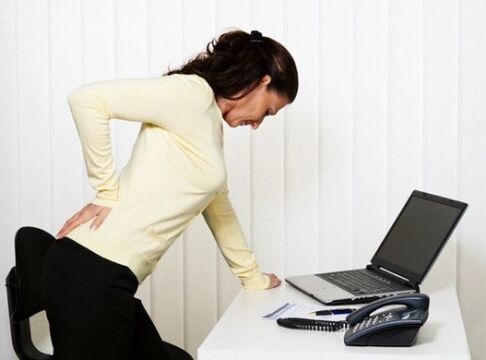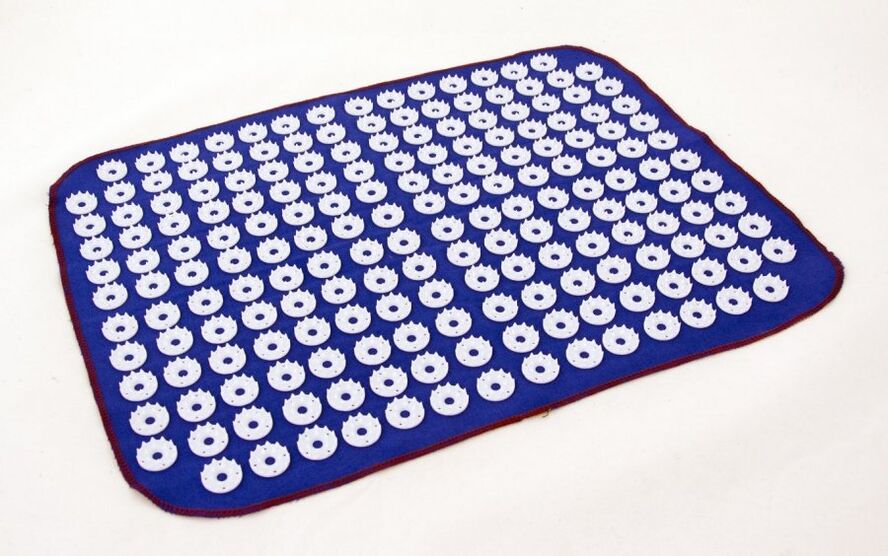
According to medical statistics, the pain on the back of 80% of cases is caused by lumbar osteochondosis.This occurs following degenerative-dystrophic changes in this segment, when the intervertebral discs and the adjacent vertebrae are affected.Osteochondrosis of the lumbar column (SPEP) manifests itself by various symptoms: pain of a different nature, limitation of mobility, altered sensitivity of the lower body, etc.With a long lack of treatment, degenerative processes apply to vertebrae, reducing work capacity, then the patient can become a disabled person.
To avoid the dangerous complications of lumbar osteochondosis (PO), you must start a complete treatment at 1-2 stages of pathology.In advanced cases, when irreversible changes in the disc or the vertebrae are already present, surgery is carried out.To avoid osteochondrosis from the lower back and related complications, it is necessary to make its prevention.
The development of lumbar osteochondrosis
To understand what is the osteochondrosis of pop (lumbar column), you must study the structure of the spine.It consists of the vertebrae, between which cartilage joints (intervertebral disc) are placed.The disc is covered with a hard fibrous membrane (fibrous ring), inside which there is a pulpose nucleus.This structure fulfills an absorbing function, makes the spine more flexible.
Reference.The lumbar segment of the spine is daily subjected to a huge load, because it resists the weight of the upper body.Consequently, osteochondrosis of the lower spine is diagnosed more often than the cervical chest.
With regular loads on the spine, the discs are compressed, many liquids are lost, their size is reduced and the distance between the vertebrae decreases.The cartilaginous joint becomes fragile, microfissures appear on its surface, through which the nucleus of the pulpose exceeds over time.With the additional compression of the intervertebral discs, the external membrane and the gelatin body loss occurs, the hernia is formed.Then, the pathological mobility of the vertebrae occurs, the load on the neighboring segments of the spine increases.
A little later, bone growth (osteophytes) begin to form on the edges of vertebral bodies.Thus, the body tries to stabilize the spine.
Doctors distinguish 4 stages of osteochondrosis from the lumbar column:
- 1 degree - The problems with the discs begin, the central part is dehydrated, it is flattened, the cracks appear on the outer shell.He has a corner.
- 2 degrees - Notices of cartilage joints, the vertebrae are approaching each other, become more mobile, the muscles and the ligaments around the spine.The pain appears.
- 3 degrees - The projection, the hernies, the subluxation of the vertebrae are formed.The pain is improved, the mobility is limited, the sensitivity of the lower body is altered.
- 4th degree osteochondrosis is characterized by the appearance of osteophytes which can damage spinal nerves, neighboring vertebrae.There is constant pain, pronounced neurological disorders and other complications, the risk of disability increases.
It is easier to cure lumbar chondrosis (stage 1), however, it is very difficult to detect the disease at this stage.2nd degree intervertebral osteochondosis is treated using conservative methods.At 3-4 steps, an operation may be necessary.
Reference.According to statistics, the SPP is more often detected in patients after 30 years.There are frequent cases of pathology in people after 20 years.About 80% of patients aged 60 suffer from manifestations of this disease.
Reasons
To understand how to manage PKOP osteochondrosis (Lombo-Sacrée vertebral column), you must know its reasons:
- Regular static or dynamic load on the lumbar segment.The risk group for the development of osteochondrosis includes office employees, professional athletes (heavy athletics), movers, manufacturers, etc.
- Posture violation, extended stay in poor pose.
- Genetic predisposition, abnormalities in the formation of vertebral bodies.This category includes young software - curvature of the spine caused by the pathologies of vertebral bodies.
- Injuries of the spine.
- Hormonal imbalance, metabolic disorders, endocrine diseases that disrupt metabolism in the lumbar segment.
- Age -related changes in the body cause disks wear.
- Bone tuberculosis, osteomyelitis (purulent inflammation of bone tissue), ankylosing spondylitis (inflammation of the vertebrae and joints), rheumatoid arthritis, etc.
Often, the disease causes several reasons at the same time.
In addition, there are factors that cause the development of lumbar osteochondosis:
- Excess body weight.
- Passive lifestyle, prolonged seat.
- Regular use of harmful foods (fat, fried food, confectionery, semi-finished products, etc.).
- Lack of liquid, dehydration.
- Congenital disorders of the structure of the spine, for example, an additional vertebra.
- Heading uncomfortable heels regular.
- The fetus carrying period, then the load on the spine increases.
- A strong abandonment of the training of professional athletes or excessive sports in people who have been passive before.
- Smoking, the consumption of frequent and immoderate alcohol.
There are many other factors that can launch degenerative-dystrophic processes in the lumbar column.For example, flat feet, frequent hypothermia, frequent stress, sleep disorders, etc.

Symptoms
The symptoms of osteochondrosis of the lumbar column are diverse, they depend on the stage of the pathology and the location of the affected area.
Doctors distinguish reflex and compression syndromes (a complex of symptoms) for the SPP.The first arise with irritation of the receptors of the external membrane of the discs, ligaments, joint capsules and the second - during the compression of the nervous beams, blood vessels, the spinal cord.
There are such reflex syndromes of lumbar osteochondrosis:
- Lumbago.Pulling pain in the back with a clear movement or tension.In me the slightest attempt to move, pain syndrome is improved, so that the patient freezes in a pose.The damaged area muscles are strongly stretched, on palpation, painful sensations become more pronounced.These manifestations are associated with the movement of the pulpose nucleus inside the external shell.
- Lumbalgia.Real pain develops for several hours or days.The discomfort intensifies with movements, a change in body position.It is weakened when a person takes a horizontal pose with a roll under the lower back.When breeding a right leg in this position, the pain intensifies (Lassa symptom).The degree of muscle tension is lower than that of the lumbar.The mobility of the lower back is limited.
- Sciatica.Painful sensations (acute or painful) propagate from the lower back to lower body.There is an increase in this functionality during movements.The pain is weakened when resting on the back.The muscles of the affected area are tense, pain syndrome is expressed on palpation.
The symptoms of compression syndromes depend on the sections of the lumbar segment are damaged.The characteristic signs are associated with the compression of the headache nerves with hernias, osteophytes, displaced vertebrae.This condition is called radiculopathy, in which pain intensifies with the slightest movement, the muscles of the lower back are tense and mobility is limited.
Clinical manifestations of compression syndromes according to the damaged vertebrae of the lumbar segment:
- L1 - L3 - Pain and numbness on the area of the lower back, the front and interior surface of the thigh, it is difficult for the patient to fold / relax the leg to the knee.
- L4 - Pain syndrome spreads to the front of the thigh, falls to the knee (behind).In the same area, sensitivity is raped.
- L5 - The painful sensations are radiated in the buttocks, the outer part of the thigh, fall along the front of the lower leg inside the foot and thumb.In the same area, numbness is felt, it is difficult for the patient to fold the thumb.
- S1 - The pain spills from the lower back to the buttock, the exterior and posterior surface of the thigh, falls towards the outer part of the lower leg, foot.In these areas, numbness is felt, the lower leg muscles are weakened, so that the patient is difficult to stand on socks.
There is a risk of damage to several nervous bundles at the same time, for example, L5, S1.If the hernia turns, it can tighten the spinal cord.
With the compression of the blood vessels from the lower back, the probability of weakening the leg muscles, numbness of the lower limbs, a violation of control over the process of urination and defecation increases.In men, an erection is disturbed in men and women, the main symptoms can be supplemented by an inflammation of the ovaries or the uterus.
Diagnostic measures
To diagnose the SPP, the doctor examines the patient, makes a palpation to determine the state of the muscles and identify the curvature of the spine.It is important to speak in detail about a specialist in his symptoms so that it is easier for him to make a diagnosis.
Instrumental research will help detect intervertebral osteochondosis:
- Lower back rail (direct back and lateral projection).
- Calculated and magnetic computed tomography.
X -Ray allows you to assess the structure of pop.To identify the pathological mobility of the vertebrae, the X -ray is made in the flexion and extension position.This study allows us to note that the intervertebral gap has shrunk, the bodies of the vertebrae moved, the osteophytes appeared on their edges.However, this diagnostic method is considered obsolete.
Today, CT and MRI are increasingly used to detect degenerative-dystrophic changes in the spine.These very informative studies allow you to assess the state of vertebrae, discs, intervertebral holes, spinal cord.With their help, their protrusion, the direction of the hernia, the degree of compression of the nervous beams, the spinal cord, the blood vessels are revealed.
Treatment
Lumbar osteochondrosis drugs

Treatment of pop osteochondrosis lasts from 1 to 3 months to 1 year.The success of therapy depends on the patient himself, which should strictly observe the doctor's recommendations.With self-medication, the patient's condition generally worsens.
Therapy therapies:
- Stop or weaken the software symptoms.
- To identify the cause of the disease, try to exclude it from life.
- Eliminate the inflammatory process.
- Restore blood circulation, metabolic processes in the lumbar region.
- Try to improve the condition of damaged cartilage joints, stop other degenerative changes.
To achieve such objectives, it is recommended to perform complex therapy.He usually starts by taking drugs:
- Musorelaxants.They relax the muscles, weaken pain and inflammation.
- NSAIDs.They have anti-inflammatory, analgesic and antipyretic effects.
- Antispasmodics.They help stop the spasm of the smooth muscles, to weaken the pain.
- Anesthetic agents.They are used for intense pain in the form of therapeutic blocking.
- Glucocorticosteroids.They also help to face pain.However, these funds are able to destroy the bones, they therefore take them for a short period and only after the doctor's approval.
- Sedatives.Remove neuromuscular tension, improve sleep.
- Vitamins (Group B, E, C, A).Restore the state of the affected nerves, weaken the pain.
Thoroughly.NSAIDs are prohibited from taking with gastritis or stomach ulcer, as they even damage the mucous membranes of the gastrointestinal tract.
With exacerbation, the patient is injected with injections, and after having stopped the main symptoms, he takes oral agents.
In addition, external products are used (gels, ointments, cream, garbage).
The question of what to do with chronic lower back osteochondosis is quite relevant.If the SPP has become chronic, after the main symptoms, the patient is prescribed chondroprotectors, drugs which restore blood circulation, drugs based on B vitamins. It helps to restore innervation, normalize the supply of affected blood and prevent the subsequent development of pathology.
The treatment of the lumbar column chondrosis (stage 1) is carried out using chondroprotectors which slow down the development of degenerative processes, accelerate the regeneration of cartilage.In addition, the patient is prescribed vitamin-mineral complexes.This form of osteochondrosis is the easiest to heal.
Other conservative methods
With OKZ (osteochondrosis) 1 to 2 degrees, the following treatment procedures will help stop its development:
- Ultrasound therapy weakens pain and inflammation, normalizes blood circulation in the damaged area.
- Dutenzor's therapy is a safe traction of the spine due to the weight of your own body, after which muscle tone is standardized, mobility improves.
- Magnetotherapy reduces the pain and inflammation of the muscles around the spine.
- Reflexotherapy (introduction of bioactive points on the body) accelerates blood circulation, relieves inflammation and swelling.
- Manual therapy (exposure to the affected area with the hands of a doctor) and massage normalize muscle tone, reduce the compression of the nervous beams, improve the power of intervertebral discs and restore the structure of the spine.
- Electrophoresis allows you to provide medicinal solutions through the skin to bones and cartilage.
- Dragonvision improves blood circulation, metabolic processes, reduces pain, restores skin sensitivity.
There are still many effective procedures that will help improve the patient's condition in 5 to 15 sessions.The main thing is to receive the approval of a doctor before their driving.
Home treatment at home
If you are interested whether it is possible to treat an OPP at home, consult a doctor.If the specialist has given permission, then start the therapy, which generally consists of the following points:
- Diet.If lumbar osteochondosis is caused by a violation of blood circulation or metabolism, exclude fatty, fried and spicy food, eggs, etc.From the menu, reconstruct the menu with fresh vegetables, fruit, low fat meat, fish, bitter products.Refuse alcohol, tonic drinks (tea, coffee).Drinking filtered water, compotes, plants based on plants.
- To restore blood circulation, exercise load or use friction and compresses.
- Sleep on an orthopedic mattress, a low pillow.If you have a sedentary job, buy a chair with a back that will support the spine.From time to time, wear corsets or special belts.
- Exercise therapy will help strengthen the muscle corset, to eliminate part of the load of the sick spine.The complex for each patient is individually a doctor or an instructor.
- Perform self-massage of the lumbar region.However, find out how to do it correctly with a professional.
- Use folk remedies in the form of friction, tablets, baths, etc.
- Acupuncture is a plastic plate with many points that improves blood circulation, metabolic processes in the damaged area, reduces muscle pain, relax.

And also at home, you can use lotions with plant decorations, plaster.
Reference.New in the treatment of osteochondrosis is a masseur bed that is even suitable for the most inorganized patients.
However, do not forget that you can only be treated at home after the authorization of the attending physician.
Surgical treatment
The operation with lumbar osteochondosis is prescribed if the conservative methods have been ineffective for a long time.And the surgical intervention is also indicated by an involuntary urination, a defecation and a ponytail syndrome (pinching of the nerves of the lower spinal cord).
In the treatment of the SPP, such surgical methods are used:
- Spondylodeza - Fusing the adjacent vertebrae.
- MAKETEXTOMY - Elimination of intervertebral joints which harm the cerebrospinal nerve.
- Laminectomy - Elimination of a plate covering the vertebral canal which tightens the spinal cord.
- Discocco is a complete or partial elimination of the intervertebral disc, which causes compression of the nerve or spinal cord.
- Corpectomy - Elimination of the body of the vertebra and adjacent cartilage joints.Then the empty place is filled with a bone transplant and a segment of 3 vertebrates is spent.
Reference.After surgery, there is a risk of complications: trauma of the spinal cord, nervous bundles, degradation of transplants, infection, etc.
After treatment, it is necessary to undergo rehabilitation to accelerate recovery.
Complications
In the absence of competent therapy, the risk of such complications of lumbar osteochondosis:
- Hernia of the disc, pinching of the nerve root or spinal cord.
- The long -term inflammatory processes increase the probability of radiculitis (inflammation of the nerve roots).
- Ishias (inflammatory damage to the sciatic nerve), in which intense pain and numbness of the lower limb occur.
- In the event of the alteration of the blood circulation of the spinal cord, the probability of compression myelopathy increases (compression of the spinal cord with various formations: bone fragments, hernia, tumors, hematoma).
- The ponytail syndrome is the compression of the roots of the lower spinal cord, which leads to a violation of the functionality of the intestines, the pelvic organs and the lower limbs.
To avoid such complications, you should start treatment as soon as possible.
Prevention
To avoid lumbar osteochondrosis, follow the following rules:
- Direct a moderately active lifestyle (walking more often on foot, regularly exercise, enter the swimming pool).
- When you sit, warm up every 1.5 hours.
- Sleep on the orthopedic mattress.
- Avoid excessive physical effort, lift the severity only from the position of the half-procedure, before that, put a special belt in the lower back.
- Buy orthopedic shoes.
- Eat properly, take vitamin-mineral complexes as prescribed by a doctor.
- Learn to relax.
- Try not to hypothermia.
- Over time, treat diseases that can cause a SPP.
- Refuse bad habits.
Subject to these recommendations, you can avoid degenerative changes in the spine and improve your health.
The most important thing
If you notice the symptoms of lumbar osteochondosis, consult a doctor urgently.Independent treatment can worsen your condition and cause complications.Lumbar chondrosis (1st step) is treated by treatment of exercise, physiotherapy and chondroprotectors.In the last stages, medicines, massage, manual therapy, etc.are used.In the absence of positive dynamics for a long time or the appearance of neurological symptoms, the doctor may prescribe an operation.The patient must strictly follow the doctor's recommendations to accelerate recovery.



































